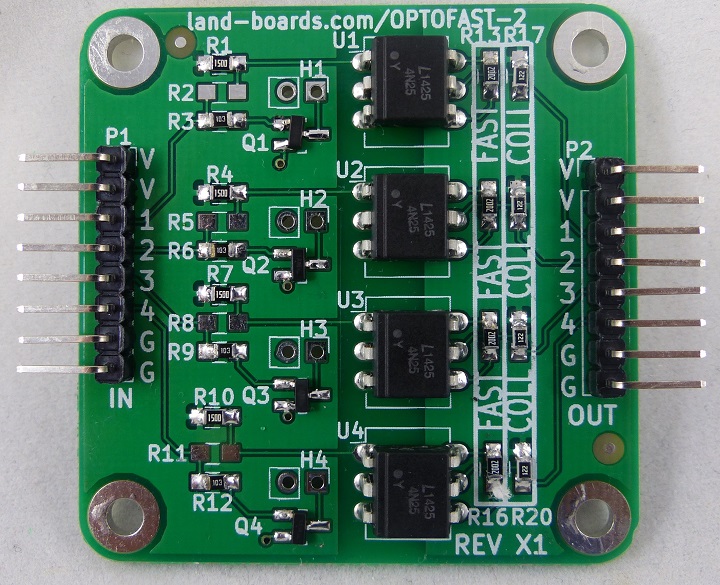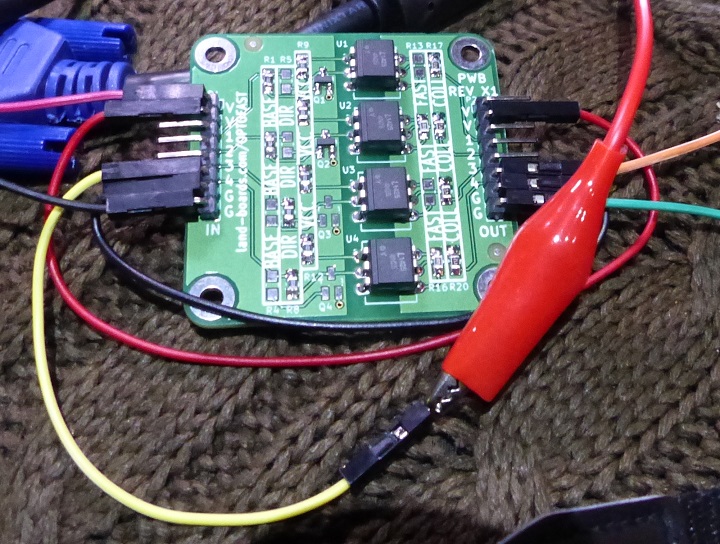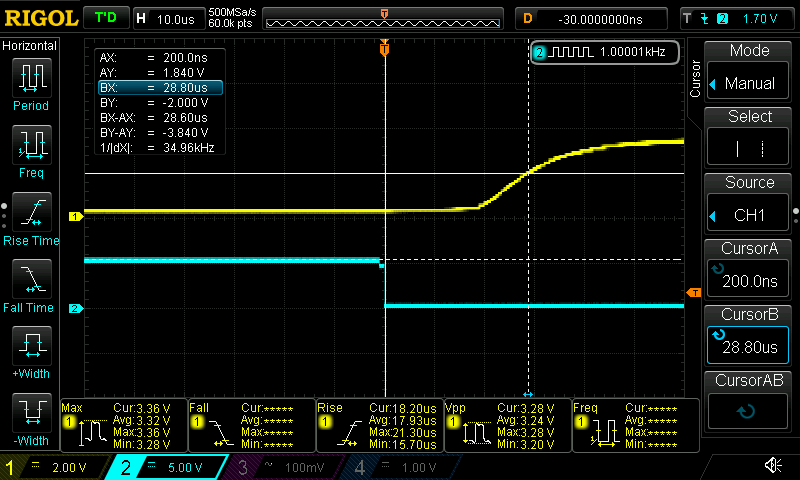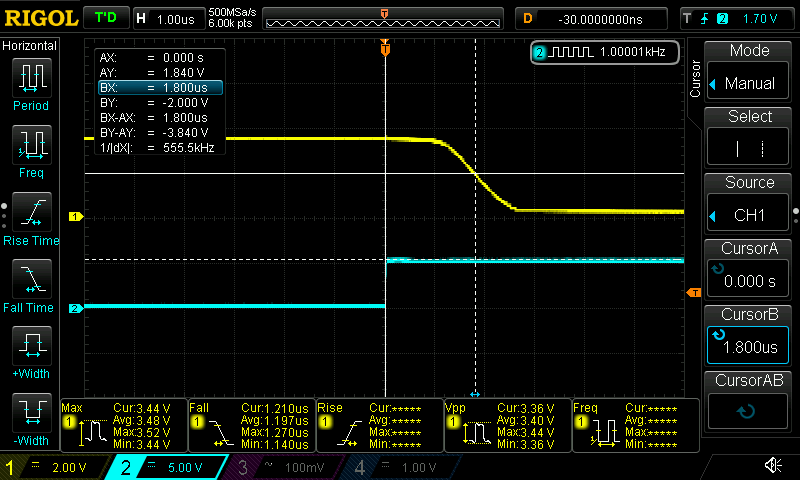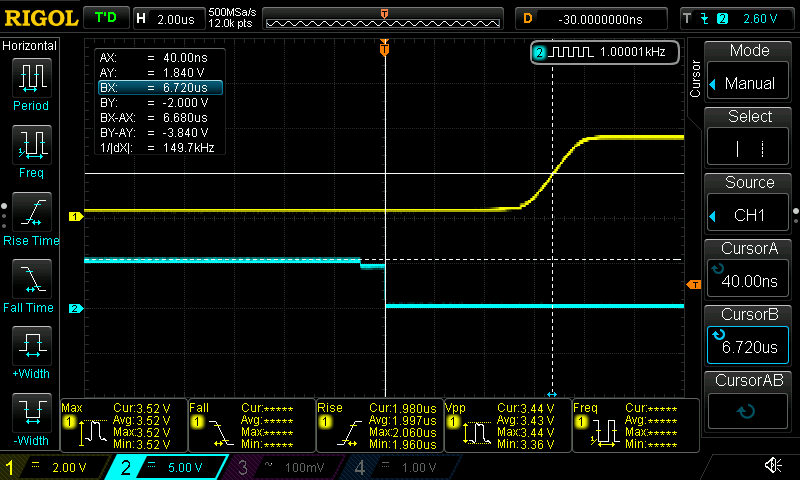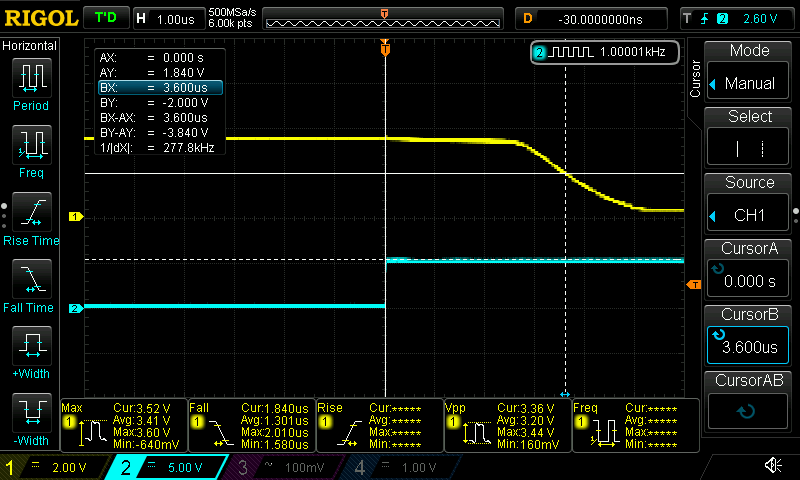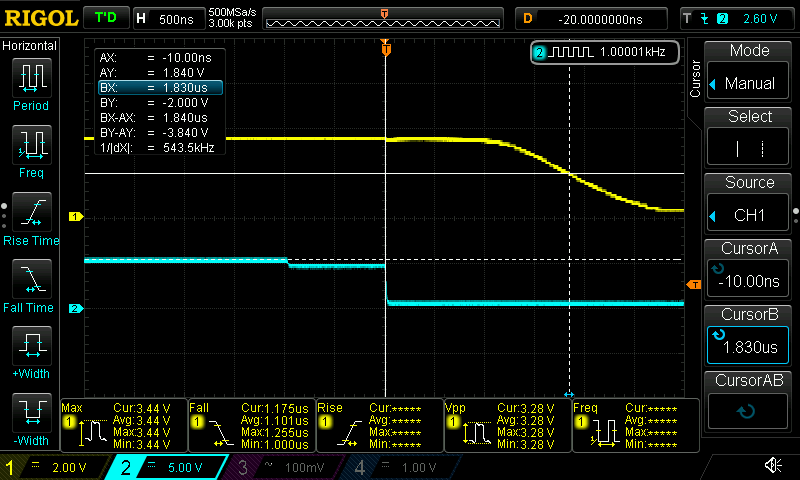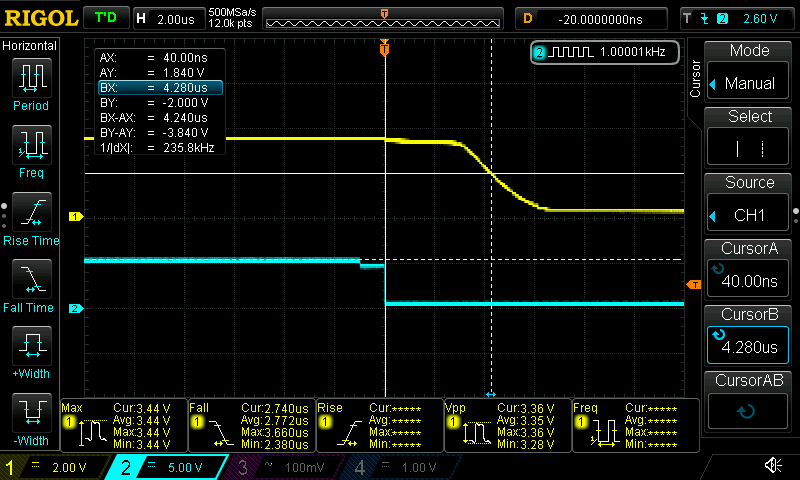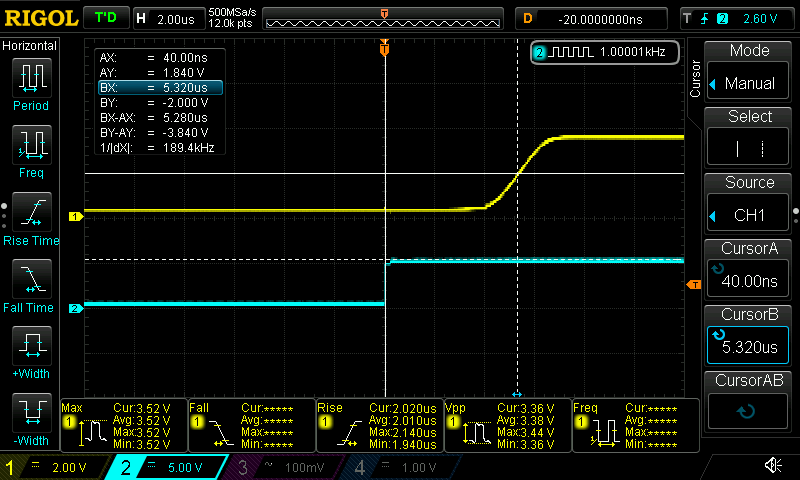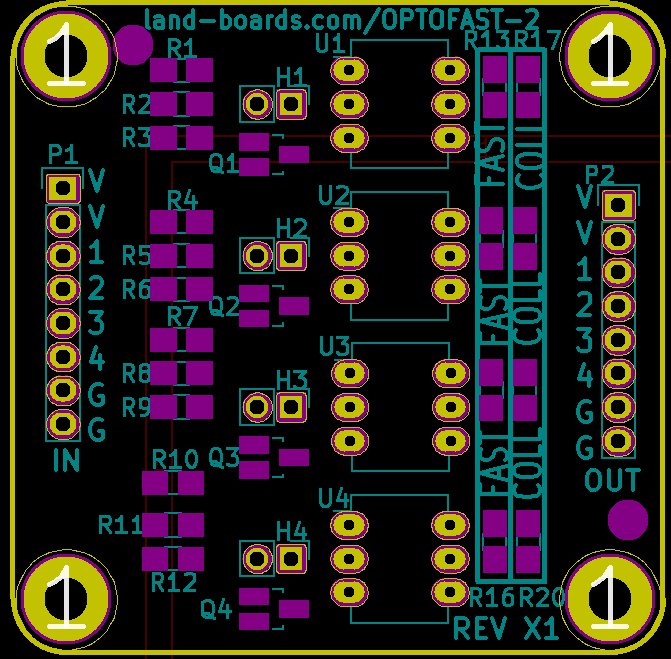Difference between revisions of "OPTOFAST-2"
Jump to navigation
Jump to search
Blwikiadmin (talk | contribs) |
Blwikiadmin (talk | contribs) |
||
| (9 intermediate revisions by the same user not shown) | |||
| Line 112: | Line 112: | ||
# GND (Out) | # GND (Out) | ||
# GND (Out) | # GND (Out) | ||
| + | |||
| + | == Calculations == | ||
| + | |||
| + | === Power Domains === | ||
| + | |||
| + | * Each side of the card has its own independent power domain | ||
| + | * Each side of the card receives external power | ||
| + | * Each side can be powered with 3.3V or 5V | ||
| + | |||
| + | === Input Drive Calculations === | ||
| + | |||
| + | * The input side of the card has optional drive transistors | ||
| + | ** 10K ohm resistors into the transistor base allows for wide input voltage range | ||
| + | ** If the input signals are 5V, then the input current is 500uA | ||
| + | |||
| + | === Output Drive Calculations === | ||
| + | |||
| + | * Output side of the card has 4.7K pullups | ||
| + | ** These determine the rise time of the output | ||
| + | |||
| + | These are the calculations for the output current: | ||
| + | |||
| + | {| class="wikitable" | ||
| + | ! Input Side | ||
| + | ! | ||
| + | ! | ||
| + | ! | ||
| + | ! | ||
| + | |- | ||
| + | | Vcc (IN) | ||
| + | | 5 | ||
| + | | V | ||
| + | | | ||
| + | | | ||
| + | |- | ||
| + | | Vf | ||
| + | | 1.2 | ||
| + | | V | ||
| + | | | ||
| + | | | ||
| + | |- | ||
| + | | Vres | ||
| + | | 3.8 | ||
| + | | V | ||
| + | | | ||
| + | | | ||
| + | |- | ||
| + | | Res | ||
| + | | 150 | ||
| + | | Ohms | ||
| + | | | ||
| + | | | ||
| + | |- | ||
| + | | If | ||
| + | | 25.33 | ||
| + | | mA | ||
| + | | | ||
| + | | | ||
| + | |- | ||
| + | | CT | ||
| + | | 0.2 | ||
| + | | A/A | ||
| + | | | ||
| + | | | ||
| + | |- | ||
| + | | Iout max | ||
| + | | 5.07 | ||
| + | | mA | ||
| + | | | ||
| + | | | ||
| + | |- | ||
| + | | Output side | ||
| + | | | ||
| + | | | ||
| + | | | ||
| + | | | ||
| + | |- | ||
| + | | Vcc (OUT) | ||
| + | | 5 | ||
| + | | V | ||
| + | | 3.3 | ||
| + | | V | ||
| + | |- | ||
| + | | Rballast | ||
| + | | 4.7 | ||
| + | | Kohms | ||
| + | | 4.7 | ||
| + | | Kohms | ||
| + | |- | ||
| + | | Iballast | ||
| + | | 1.06 | ||
| + | | mA | ||
| + | | 0.70 | ||
| + | | mA | ||
| + | |- | ||
| + | | IL out avail | ||
| + | | 4.00 | ||
| + | | mA | ||
| + | | 4.36 | ||
| + | | mA | ||
| + | |- | ||
| + | | | ||
| + | | | ||
| + | | | ||
| + | | | ||
| + | | | ||
| + | |- | ||
| + | | Input Side | ||
| + | | | ||
| + | | | ||
| + | | | ||
| + | | | ||
| + | |- | ||
| + | | Vcc (IN) | ||
| + | | 3.3 | ||
| + | | V | ||
| + | | | ||
| + | | | ||
| + | |- | ||
| + | | Vf | ||
| + | | 1.2 | ||
| + | | V | ||
| + | | | ||
| + | | | ||
| + | |- | ||
| + | | Vres | ||
| + | | 2.1 | ||
| + | | V | ||
| + | | | ||
| + | | | ||
| + | |- | ||
| + | | Res | ||
| + | | 150 | ||
| + | | Ohms | ||
| + | | | ||
| + | | | ||
| + | |- | ||
| + | | If | ||
| + | | 14.00 | ||
| + | | mA | ||
| + | | | ||
| + | | | ||
| + | |- | ||
| + | | CT | ||
| + | | 0.2 | ||
| + | | A/A | ||
| + | | | ||
| + | | | ||
| + | |- | ||
| + | | Iout max | ||
| + | | 2.80 | ||
| + | | mA | ||
| + | | | ||
| + | | | ||
| + | |- | ||
| + | | Output side | ||
| + | | | ||
| + | | | ||
| + | | | ||
| + | | | ||
| + | |- | ||
| + | | Vcc (OUT) | ||
| + | | 5 | ||
| + | | V | ||
| + | | 3.3 | ||
| + | | V | ||
| + | |- | ||
| + | | Rballast | ||
| + | | 4.7 | ||
| + | | Kohms | ||
| + | | 4.7 | ||
| + | | Kohms | ||
| + | |- | ||
| + | | Iballast | ||
| + | | 1.06 | ||
| + | | mA | ||
| + | | 0.70 | ||
| + | | mA | ||
| + | |- | ||
| + | | IL out avail | ||
| + | | 1.74 | ||
| + | | mA | ||
| + | | 2.10 | ||
| + | | mA | ||
| + | |- | ||
| + | |} | ||
== Test Card Measurements == | == Test Card Measurements == | ||
| Line 141: | Line 327: | ||
=== Test Results=== | === Test Results=== | ||
| − | + | ||
| − | 1 Slow Transistor Buffer Fall 28.6 | + | {| class="wikitable" |
| − | 1 Slow Transistor Buffer Rise 1.8 | + | ! Channel |
| − | 2 Fast Transistor Buffer Fall 6.68 | + | ! Fast/Slow |
| − | 2 Fast Transistor Buffer Rise 3.6 | + | ! TransBuff/Direct |
| − | 3 Slow Direct Input Fall 1.84 | + | ! Input Rise/Fall |
| − | 3 Slow Direct Input Rise 27.4 | + | ! Time(uS) |
| − | 4 Fast Direct Input Fall 4.24 | + | |- |
| − | 4 Fast Direct Input Rise 5.28 | + | | 1 |
| − | + | | Slow | |
| + | | Transistor Buffer | ||
| + | | Fall | ||
| + | | 28.6 | ||
| + | |- | ||
| + | | 1 | ||
| + | | Slow | ||
| + | | Transistor Buffer | ||
| + | | Rise | ||
| + | | 1.8 | ||
| + | |- | ||
| + | | 2 | ||
| + | | Fast | ||
| + | | Transistor Buffer | ||
| + | | Fall | ||
| + | | 6.68 | ||
| + | |- | ||
| + | | 2 | ||
| + | | Fast | ||
| + | | Transistor Buffer | ||
| + | | Rise | ||
| + | | 3.6 | ||
| + | |- | ||
| + | | 3 | ||
| + | | Slow | ||
| + | | Direct Input | ||
| + | | Fall | ||
| + | | 1.84 | ||
| + | |- | ||
| + | | 3 | ||
| + | | Slow | ||
| + | | Direct Input | ||
| + | | Rise | ||
| + | | 27.4 | ||
| + | |- | ||
| + | | 4 | ||
| + | | Fast | ||
| + | | Direct Input | ||
| + | | Fall | ||
| + | | 4.24 | ||
| + | |- | ||
| + | | 4 | ||
| + | | Fast | ||
| + | | Direct Input | ||
| + | | Rise | ||
| + | | 5.28 | ||
| + | |- | ||
| + | |} | ||
=== Observations === | === Observations === | ||
| Line 197: | Line 430: | ||
[[File:Ch4-Fast-Direct-InRise.png]] | [[File:Ch4-Fast-Direct-InRise.png]] | ||
| + | |||
| + | == Factory Test == | ||
| + | |||
| + | * [http://land-boards.com/blwiki/index.php?title=Arduino_Based_Test_Station ODAS Card Test Station] | ||
| + | ** Running [https://github.com/land-boards/lb-Arduino-Code/tree/master/LBCards/ODAS/ODASTESTER ODASTESTER code] | ||
| + | * [[DB37RIBBON]] | ||
| + | * Cable set | ||
| + | * PC running PuTTY | ||
| + | ** 9600 baud | ||
| + | ** USB-C cable | ||
| + | *** USB connected to PC and USB-C connected to [[BLACK-PILL-HUB]] | ||
| + | * Powered through the USB-C connector on the [[STM32 Black Pill]] | ||
| + | |||
| + | <pre> | ||
| + | Checking if EEPROM is present on UUT...EEPROM is not present on UUT | ||
| + | Count of I2C devices in range 0x20-0x27 on UUT = 0 | ||
| + | No external I2C mux card | ||
| + | Select the board type (Other) | ||
| + | 4 - OPTOFast/Small Non-Inverting board | ||
| + | 5 - OPTOFast/Small Inverting board | ||
| + | 6 - OptoFastBi board | ||
| + | Select board > 5 | ||
| + | C=Card Tests, D=Direct, E=EEPROM, I=access Internal DIGIO32 | ||
| + | L=Loop/S=Single, T=Test, B=Bounce LEDs, I=UUT Int'l Tests, X=eXit sub-menu | ||
| + | Testing UUT = Opto Inc | ||
| + | Error on port 0 Expected Low | ||
| + | Test PASS = 0, FAIL = 1 | ||
| + | </pre> | ||
== Layout == | == Layout == | ||
Latest revision as of 20:46, 30 March 2023
Contents
Features
- Opto-Isolator card
- 4-Channels
- 4N25 Optoisolators
- Input /Output isolation
- Transistor driver for Opto LED reduces required drive from 10 mA to under 500 uA
- Input channels share their own common VCC/Ground
- Output channels share their own common Vcc/Ground
- 8-pin header for input
- 8-pin header for output
- Configuration Options
- Speed enhanced
- Bypass Input transistors
- Remove Output collector resistors
- 49x49mm
- (4) 4-40 mounting holes
Schematic (One channel)
- U1 represents U1-U4 (channels 1-4)
- Q1 represents Q1-Q4 (channels 1-4)
- R1 (VCC) represents R1,R4,R7,R10 (channels 1-4)
- R2 (DIR) represents R2,R5,R8,R11 (channels 1-4)
- R3 (BASE) represents R3,R6,R8,R12 (channels 1-4)
- R13 (FAST) represents R13-R16 (channels 1-4)
- R17 (COLL) represents R17-R20 (channels 1-4)
Input Options
- Refer to schematic for impact of options
Use Input Transistor - Standard Option
- Common VCC in option
- Install transistor Q1
- R1 = 150
- LED current is 3.5V/150 Ohms = 23 mA
- CTR = .20, 4.7 mA
- R2 = Do not populate
- R3 = 10K
- Base drive ~ (Vin - 0.7V)/R3
- At 5V drive this is 4.3V/R3
- Using R3=10K at 5V this is 0.43mA Ib
- HFE (MMBT3904) = 100 min
- That is potentially 43 mA (in the switching range of the transistor)
- Collector resistor and LED voltage drop are current limiter
- At 3.3V drive this is (3.3-0.7)/10K = .26mA Ib
- HFE = 100 min
- That is 26 mA (in the switching range of the transistor)
- H1 do not short
Direct Drive - Special Option
- Do not install Q1
- Do not install R1
- R2 = 150
- Input current = LED current = 3.5V/150 Ohms = 23 mA
- Do not install R3
- Do not install Q1
- Short H1
Output Options
Standard Output
- R17 = 1.2K
- 5V/1.2K = 4.1mA of output transistor B-E current
- Leaves 4.7-4.1 mA = 600 uA of output low current
Open Collector Output - Special Option
- Do not install R17
Fast Option - Standard
- R13 = 20K (empirically determined from the scope eye)
Connectors
P1 - Input
8-pin, right angle, 0.1" pitch
- Vcc (In)
- Vcc (In)
- IN 1
- IN 2
- IN 3
- IN 4
- GND (In)
- GND (In)
P2 - Output
8-pin, right angle, 0.1" pitch
- Vcc (Out)
- Vcc (Out)
- OUT 1
- OUT 2
- OUT 3
- OUT 4
- GND (Out)
- GND (Out)
Calculations
Power Domains
- Each side of the card has its own independent power domain
- Each side of the card receives external power
- Each side can be powered with 3.3V or 5V
Input Drive Calculations
- The input side of the card has optional drive transistors
- 10K ohm resistors into the transistor base allows for wide input voltage range
- If the input signals are 5V, then the input current is 500uA
Output Drive Calculations
- Output side of the card has 4.7K pullups
- These determine the rise time of the output
These are the calculations for the output current:
| Input Side | ||||
|---|---|---|---|---|
| Vcc (IN) | 5 | V | ||
| Vf | 1.2 | V | ||
| Vres | 3.8 | V | ||
| Res | 150 | Ohms | ||
| If | 25.33 | mA | ||
| CT | 0.2 | A/A | ||
| Iout max | 5.07 | mA | ||
| Output side | ||||
| Vcc (OUT) | 5 | V | 3.3 | V |
| Rballast | 4.7 | Kohms | 4.7 | Kohms |
| Iballast | 1.06 | mA | 0.70 | mA |
| IL out avail | 4.00 | mA | 4.36 | mA |
| Input Side | ||||
| Vcc (IN) | 3.3 | V | ||
| Vf | 1.2 | V | ||
| Vres | 2.1 | V | ||
| Res | 150 | Ohms | ||
| If | 14.00 | mA | ||
| CT | 0.2 | A/A | ||
| Iout max | 2.80 | mA | ||
| Output side | ||||
| Vcc (OUT) | 5 | V | 3.3 | V |
| Rballast | 4.7 | Kohms | 4.7 | Kohms |
| Iballast | 1.06 | mA | 0.70 | mA |
| IL out avail | 1.74 | mA | 2.10 | mA |
Test Card Measurements
Setup
- Goal was to determine the performance of the OPTOFAST card
- 5V operation
- Same 5V input/output power supply
- Each of the channels were configured uniquely/individually
- MHS-5200A - Digital DDS Dual-channel Signal Generator
- 1 KHz square wave
- 5V signal level
- Single channel checked at a time
- Oscilloscope
- Rigol DS1054Z
- 50 MHz
- Ultra Sigma software used for screen captures
Notes
- Note that the input buffer transistor inverts the signal
- Built a card that has four different configurations
- Options
- Fast/Slow
- Direct drive input LED/Transistor Buffered input
Test Results
| Channel | Fast/Slow | TransBuff/Direct | Input Rise/Fall | Time(uS) |
|---|---|---|---|---|
| 1 | Slow | Transistor Buffer | Fall | 28.6 |
| 1 | Slow | Transistor Buffer | Rise | 1.8 |
| 2 | Fast | Transistor Buffer | Fall | 6.68 |
| 2 | Fast | Transistor Buffer | Rise | 3.6 |
| 3 | Slow | Direct Input | Fall | 1.84 |
| 3 | Slow | Direct Input | Rise | 27.4 |
| 4 | Fast | Direct Input | Fall | 4.24 |
| 4 | Fast | Direct Input | Rise | 5.28 |
Observations
- Input Transistor effect
- Value of the input transistor is that does not require a high drive level input
- The input transistor has very little effect on speed - a couple hundred nS slower than direct drive
- The inversion effect of the input transistor moves the "slow" time around
- Downside of the input transistor is that it has less noise immunity since the transistor turns on at 0.6V vs the internal LED in the optocoupler at 1.5V?
- Output "fast" circuit
- Output pullup of 4.7K affects the rise time of the output
- The fast is faster, but not in some conditions
- Average of rise/fall is better
- Transistor buffer instance rise input is slower with the fast output
- Fast output helps the output rise time
Ch1-Slow-NPNBuffer-InFall
Ch1-Slow-NPNBuffer-InRise
Ch2-Fast-NPNBuffer-InFall
Ch2-Fast-NPNBuffer-InRise
Ch3-Slow-Direct-InFall
Ch3-Slow-Direct-InRise
Ch4-Fast-Direct-InFall
Ch4-Fast-Direct-InRise
Factory Test
- ODAS Card Test Station
- Running ODASTESTER code
- DB37RIBBON
- Cable set
- PC running PuTTY
- 9600 baud
- USB-C cable
- USB connected to PC and USB-C connected to BLACK-PILL-HUB
- Powered through the USB-C connector on the STM32 Black Pill
Checking if EEPROM is present on UUT...EEPROM is not present on UUT Count of I2C devices in range 0x20-0x27 on UUT = 0 No external I2C mux card Select the board type (Other) 4 - OPTOFast/Small Non-Inverting board 5 - OPTOFast/Small Inverting board 6 - OptoFastBi board Select board > 5 C=Card Tests, D=Direct, E=EEPROM, I=access Internal DIGIO32 L=Loop/S=Single, T=Test, B=Bounce LEDs, I=UUT Int'l Tests, X=eXit sub-menu Testing UUT = Opto Inc Error on port 0 Expected Low Test PASS = 0, FAIL = 1

